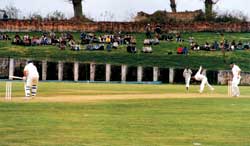 There is new euphoria in the air for Nepali cricket, and that is not just because of the World Cup. A series of outstanding victories in the under-19 World Cup and the Asian Cricket Council Trophy got our lads noticed in the international arena last year. Then last week, Nepal showed vigorous performance in the Emerging Nations Cup in Kathmandu. Experts now rate the Nepali team 2nd among non-test playing nations in Asia. The UAE, number one on the list, relies heavily on imported players from India, Pakistan and Sri Lanka. With proper training and infrastructure, there seems to be no reason why we can't be up there with the greats.
There is new euphoria in the air for Nepali cricket, and that is not just because of the World Cup. A series of outstanding victories in the under-19 World Cup and the Asian Cricket Council Trophy got our lads noticed in the international arena last year. Then last week, Nepal showed vigorous performance in the Emerging Nations Cup in Kathmandu. Experts now rate the Nepali team 2nd among non-test playing nations in Asia. The UAE, number one on the list, relies heavily on imported players from India, Pakistan and Sri Lanka. With proper training and infrastructure, there seems to be no reason why we can't be up there with the greats. The Cricket Association of Nepal (CAN) is trying to build more cricket venues with turf wickets in Birganj, Pokhara and possibly Biratnagar. The one in Birgunj will be the biggest in Nepal. CAN is also negotiating maintenance of a local school ground in Rajbiraj. Hopefully this will result in year-round tournaments.
CAN recently brought out its first cricket calendar. It organised the Emerging Nations Cup where national teams from the Maldives and Bhutan participated. Thanks to a tie-up with Bombay-based event management company, Percept D'Mark, Nepal can now play against international teams on home territory. The Ranji Trophy champions from India will be visiting Kathmandu for three matches. The legendary Marylebone Cricket Club (MCC) from Australia are already here to play four matches and take part in a training scheme for coaches. The Pakistani team led by former test player, Majid Khan, will also visit Nepal this year. A significant step taken by CAN has been the introduction of the under-13 league. This will ensure an upward flow of talent from young players to seasoned cricketers.
The 2003 Asia Cup will be very special for cricket fans and players in Nepal. For the first time, local talent will be pitched against the likes of Sanath Jayasuriya, Shoaib Akthar and Sachin Tendulkar. No one had dreamt of such an achievement when Nepal began its international cricket campaign in 1996.
Cricket has come a long way since the anglophile Ranas introduced cricket to Nepal in the 1920s. The game was brought out of the high walls after democracy. But the sport still didn't click here as it did in the former British colonies of the subcontinent.
The greatest disadvantage faced by Nepali cricket has been the lack of infrastructure. The absence of grounds and proper practice pitches has meant a lot of cricket talent has gone fallow or unnoticed. International matches are played on grass or turf wickets whereas in Nepal, practice sessions are held on mats and cement wickets. This leaves Nepali players unprepared to play on proper turf, and this is apparent in weak batting displays. Ideally, players must have access to all three types of wickets to prepare them for different bowling and batting conditions.
Professional cricket, with it's various lucrative perks, has yet to take off. At present there are too few incentives to keep players motivated to play for the country. CAN has been unable to attract sponsors like Gorkha Brewery which was the first to officially sponsor the Nepali cricket team under the Carlsberg banner. It has provided significant financial assistance to the Birendra National League and made arrangements for memberships at well-equipped health clubs. But Nepali cricket needs more than one corporate sponsor and the ICC grant to play world class cricket.
Everyone is convinced that Nepali cricket has the potential to go far. From cricket administrators to fans, everyone is abuzz with the possibility of qualifying for the next Cricket World Cup to be held in the Caribbean in 2007. The question is whether we will be able to maintain steady growth and success and get one-day status. "We're hopeful that Nepal can qualify for the next World Cup," says Jaya Kumar Nath Shah, president of CAN. He takes heart from Kenya, Namibia and Holland's positive achievements in this year's World Cup.
But he says only a continued and consolidated effort can ensure Nepal\'s cricket growth. If Nepal is to play competitively and successfully in the international arena, we must move on from one-day cricket. The International Cricket Council (ICC) has changed its qualification process for non-test playing nations with regard to the World Cup. For the first time the ICC's 27 affiliate members and 47 associate members have been guaranteed a regular program of competitive international cricket through the launch of the ICC's World Cup Qualifying Series (WCQS).
WCQS starts in 2003 with 27 nations taking part in four different tournaments between July and October that are based on merit, not geographical location. The top three divisions each have six teams and there will be promotion and relegation between the first and last team of each division. Division Four is different in that there will initially be nine teams and, significantly, the bottom six teams will have to re-qualify for the 2005 World Group by beating the Affiliate nations within their region.
The inaugural World Group tournaments will take place between July and October 2003 in Kenya, USA, Malaysia and Italy. Nepal is in division two where it has to fight Ireland, Denmark, USA, Bermuda and Uganda. In October, the Nepali team will travel to Los Angeles for its World Group tournaments.


